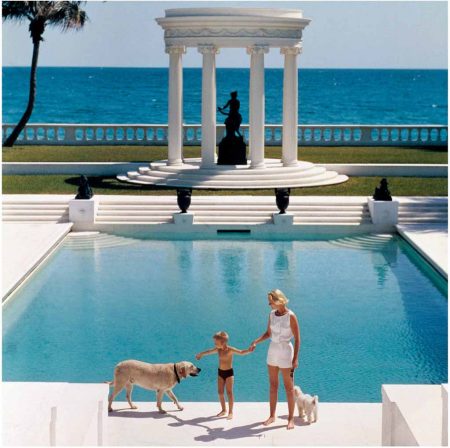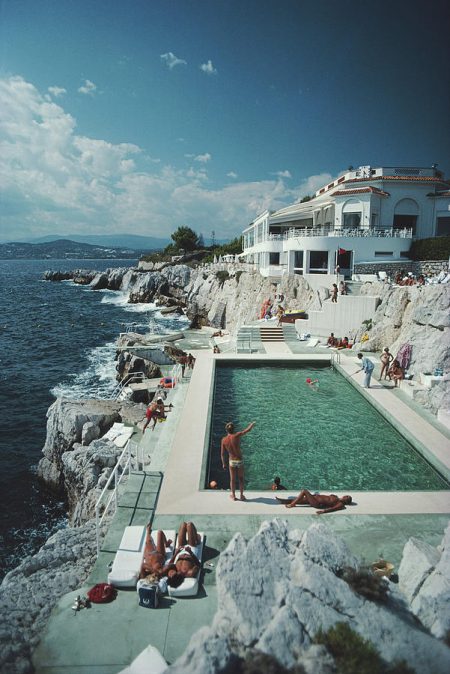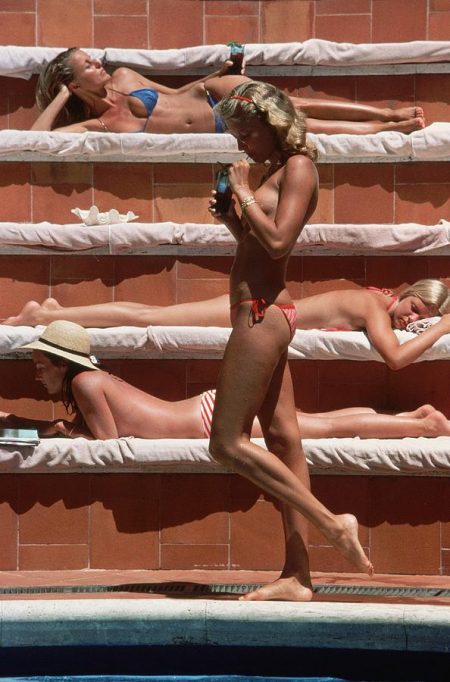For decades, from the 1950s through 1970s, Slim Aarons (1916-2006) recorded the lives of the “rich and famous” He caught them at their favorite watering holes: Beverly Hills, Palm Beach, Park Avenue, Capri, Gstaad, the French and Italian rivieras. You name it and he was there. He was a documentary photographer as sure as Walker Evans, Dorothea Lange, Henri Cartier-Bresson, and Robert Frank. But instead of the down-and-out and mundane, Aarons photographed “attractive people doing attractive things in attractive places.”

In 2020, in “Slim Aarons, King of Hollywood Photographers (A Story of Faking It…And Making it)” in Groovy History.com, the writer Jacob Shelton wrote:
His frequent subjects, to quote a sitcom theme, were “swimming pools and movie stars–throw in wealthy vacationers, chic skiers, and obscure royalty, and you get some idea of the circles in which Aarons moved. He hopped from fabulous locale to fabulous locale like a camera-slinging James Bond, hobnobbing with the upper crust and capturing their enviable leisure lifestyles.
Not bad for a kid born in 1916 into a Yiddish-speaking family on New York’s Lower East Side. That biography wouldn’t do for his career as a celebrity photographer, so he dropped George Allen Aarons and took the name “Slim,” which fit the lanky six+-footer. And instead of the tenements, he claimed to have been born on a farm in New Hampshire, a nice waspy cover for his Jewish roots.

At 18 he enlisted in the Army and became the official photographer at West Point. When WWII started, Yank, the Army Weekly, sent him as a combat photographer (he received a Purple Heart) to North Africa, the Middle East, and Rome. After the war, Aarons turned down an assignment from Life to photograph the Korean War and headed west to the warm waters of the Pacific. He arrived in California with little money but the proverbial big dream. Through his connections he’d made at Yank, he got freelance gigs photographing society parties.
As to how a guy with a camera became a part of the world he photographed, Aarons explained to The Independent, London, in 2002, that “They (the glitterati) would invite me to one of their parties because they knew I wouldn’t hurt them. I was one of them.”
Aarons’ work found its way to all the right magazines: Life, Holiday, Vogue, Harper’s Bazaar, and Town & Country.
Clay Felker, co-founder with Milton Glaser of New York magazine, compared Aarons to a “guerilla.” He got in and out with barely a ripple. Using only available light, he never costumed and rarely posed his subjects.
There are only five Aarons photographs on view at Miller Gallery’s pop-up gallery, Twenty20. They all come from Getty Images’ Hulton Archive and are not editioned so whatever strikes your fancy can be had in a variety of sizes and printed on anything from canvas to metal. Additional images in the Archive are also available.
In 1997, on the strength of a handshake, Aarons sold his entire archive to Mark Getty, co-founder of Getty Images, for an undisclosed amount. Aarons explained, “He gave me what I call ‘Fuck you’ money. Remember–because this is important–you’re never free until you have ‘Fuck you’ money.” When Aarons died at the age of 89 in 2006, he had millions in his bank account.

There’s a stop-action quality to Aarons’ work; he captures Cartier-Bresson’s “decisive moment.” Sea Drive illustrates it perfectly. A red “amphicar” cruises across the Nassau harbor with the film producer Kevin McClory at the wheel; his wife, Bobo Sigrist, and three of his children are along for the ride. Despite the boat’s wake and Sigrist’s long hair being blown back in the breeze, there seems to be no movement. It’s like a film still.

One of those parties Aarons attended was at the Kaufmann Desert House in Palm Springs. It was designed in 1946 by Richard Neutra for the businessman and philanthropist Edgar J. Kaufmann. Aarons’ photographs are far from timeless. They always describe a specific moment in time. Dressed in yellow, Nelda Linsk, wife of the art dealer Joseph Linsk, listens attentively to the industrial designer Raymond Loewy in a Madras sports coat. In the foreground is the former fashion model–see how she stands–Helen Dzo Dzo. Her lacy ensemble reveals a perfectly toned midriff. With a helmet of blonde hair (thank you very much Aqua Net), she stands next to a dark long-haired woman who is engaged in a conversation with a surfer-blonde guy who is wearing a truly unfortunate green paisley sports coat. Helen observes the pair, more decorative note than participant.

“Ninety-nine percent of my contemporaries kept on reporting about the miseries and worries of the world after the war. But hell someone had to do the other stuff.”
And so he did, leaving a chronicle of the “rich and famous” in the mid-20th century.
If Aarons were shooting today, the group might include the artist formerly known as Prince instead of Prince Richard zu Sayn-Wittgenstein; the Kardashians are a poor substitute for the Gabor sisters; and Melania Trump is no Jackie O. The “golden age” has become the ”gilded” age.
–Karen S. Chambers
Slim Aarons, Twenty/20 Art, Miller Gallery, 2709 Erie Ave., Cincinnati, OH 45208, 513-415-7762, [email protected]; Tues. 1:00 pm-5:30 pm, Wed.-Fri. 11:00 am-5:30 pm, Sat. noon-5:00 pm